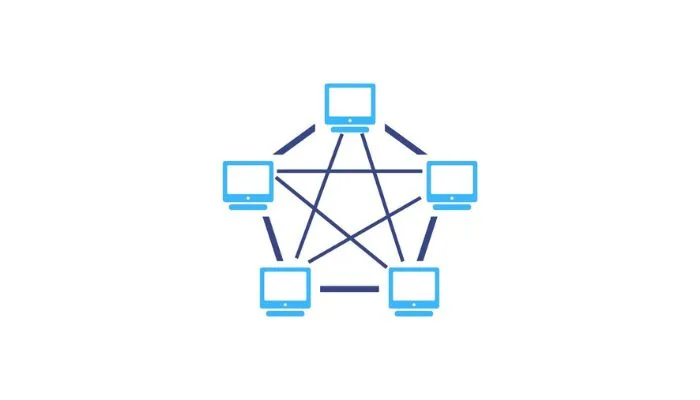What is Mesh Topology?
Imagine a network where devices, or nodes, connect seamlessly, branching off one another, creating an intricate web of connections. This is the essence of a mesh network. These networks are designed to efficiently route data between devices and clients, ensuring a consistent connection throughout a physical space. Learn more about What is Network Topology and what types of topology?
In a mesh network, each and every one of the computers is connected to and communicates with the other computers in the network. Every computer, in addition to transmitting its own signals, also serves as a relay for the data coming from other computers.
There are N(N-1)/2 links in the mesh if there are N nodes, and the nodes are all entirely connected to one another by a dedicated link that allows for the transfer of information from one node to the next. Every node has a direct link to every other node in the network in the form of a point-to-point connection. In a mesh, the connections between nodes are often either wired or wireless.

How Do Mesh Networks Work?
Mesh networks operate by utilizing routing or flooding techniques to transmit messages between nodes. Routing involves data hopping from node to node until it reaches its intended destination. These networks incorporate self-healing algorithms to reconfigure paths in case of node or connection failures. Additionally, there are usually multiple paths available between a source and destination.
- Flooding techniques, on the other hand, distribute data from one node to the entire network. Not all nodes need to be available simultaneously, as a protocol selects senders for each data transmission to maximize throughput.
- Routing involves messages hopping from node to node, with the network reconfiguring itself if a path is disrupted, thanks to self-healing algorithms. Meanwhile, flooding techniques distribute data from one node to others, optimizing data transmission and throughput.
Types of Mesh Topology
There are two main types of mesh topology:
- Full Mesh Topology: In this type, every device is connected to every other device. It’s like a web of connections with no missing links.
- Partial Mesh Topology: Here, some devices are connected to all others, while some have limited connections. It’s like a web where a few strands are missing.
Use Cases for Mesh Networks
- Home Monitoring: Connecting smart home devices to a central hub for monitoring and control.
- Industrial Monitoring and Control: Managing sensors and devices in industrial settings.
- Medical Monitoring: Supporting medical equipment for data transmission.
- Security Systems: Creating robust security systems with interconnected cameras and sensors.
- Public Service Communication: Enabling communication between public service devices and infrastructure.
Advantages of Mesh Topology
- Increased Stability: Mesh networks are resilient to single points of failure, ensuring network stability.
- Extended Range: They can transmit signals over greater distances, reducing Wi-Fi dead spots.
- Direct Communication: Nodes can communicate directly with one another without relying on a central access point.
- Lower Power Consumption: Each node doesn’t need to transmit a strong signal, conserving power.
- Better Security: In the event of an attack, individual nodes can be easily replaced.
- Simplified Topology: Mesh networks require less infrastructure than traditional network configurations.
Disadvantages of Mesh Topology
- Cost: Setting up a mesh network can be more expensive than a single router and range extenders.
- Scalability: Expanding a mesh network may become complex, depending on the number of nodes required.
- Complexity: Managing and troubleshooting a large number of nodes can be challenging.
- Latency: In lower-power WANs, latency can be an issue due to processing limitations.
- Power Consumption: Deploying lower-powered nodes can be difficult in some cases.
Mesh Networks vs. Traditional Wi-Fi
The primary distinction is that traditional Wi-Fi relies on a centralized router as the access point, while mesh networks distribute connectivity across multiple interconnected nodes. In Wi-Fi, all traffic is funneled through the central access point, while mesh networks allow devices to connect through the most efficient route, enhancing coverage and reliability.
Mesh networks are typically favored for larger areas where a single router’s coverage is insufficient, while traditional Wi-Fi is more cost-effective for smaller spaces.
Security in Mesh Networks
Security is a crucial aspect of any network. Here’s how you can keep your mesh network secure:
- Use Strong Passwords: Ensure that your network and device passwords are robust.
- Regularly Update Firmware: Keep your mesh devices up to date with the latest security patches.
- Enable Encryption: Use encryption protocols to protect data transmission within your network.
Mesh vs. Other Network Topologies
You might wonder how mesh topology compares to other network setups:
- Bus Topology: In bus topology, all devices are connected to a single cable. Mesh is more robust and fault-tolerant.
- Star Topology: In star topology, all devices are connected to a central hub. Mesh doesn’t rely on a single point of failure.
- Ring Topology: Devices in a ring topology are connected in a circle. Mesh is more adaptable and scalable.
Frequently Asked Questions (FAQs)
Mesh Topology differs in that every device connects to every other device, providing redundancy and fault tolerance, unlike other topologies like Bus or Star.
Mesh Topology can be cost-prohibitive for small businesses due to the extensive cabling required. It’s more commonly used in large-scale networks.
Yes, it’s possible to create hybrid topologies that incorporate elements of Mesh Topology along with other configurations like Star or Bus to suit specific network requirements.
Regular monitoring and maintenance are essential to address issues like cable failures, device malfunctions, and optimizing data routing.
Yes, wireless Mesh networks eliminate the need for physical cables, making them more adaptable for certain applications like home automation and outdoor wireless coverage.
Yes, Mesh Topology networks can be secured through encryption, access control, and regular security updates to devices.

